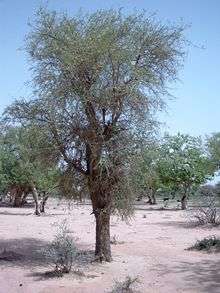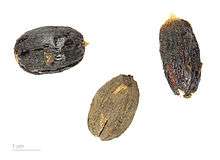Balanites aegyptiaca
| Balanites aegyptiaca | |
|---|---|
 | |
| Scientific classification | |
| Kingdom: | Plantae |
| (unranked): | Angiosperms |
| (unranked): | Eudicots |
| (unranked): | Rosids |
| Order: | Zygophyllales |
| Family: | Zygophyllaceae |
| Genus: | Balanites |
| Species: | B. aegyptiaca |
| Binomial name | |
| Balanites aegyptiaca (L.) Delile, 1812 | |
| Synonyms | |
|
Ximenia aegyptiaca L. | |

Balanites aegyptiaca is a species of tree, classified either as a member of the Zygophyllaceae or the Balanitaceae.[1] This tree is native to much of Africa and parts of the Middle East.[2]
There are many common names for this plant.[3] In English the fruit has been called desert date, soap berry tree or bush, Thron tree, Egyptian myrobalan, Egyptian balsam or Zachum oil tree;[4] in Arabic it is known as lalob, hidjihi, inteishit, and heglig (hijlij). In Hausa it is called aduwa, in Swahili mchunju and in Amharic bedena.[5]
Distribution
Balanites aegyptiaca is found in the Sahel-Savannah region across Africa. It is one of the most common trees in Senegal and Mauritania, one of its local names is teishit.[6] It can be found in many kinds of habitat, tolerating a wide variety of soil types, from sand to heavy clay, and climatic moisture levels, from arid to subhumid.[7] It is relatively tolerant of flooding, livestock activity, and wildfire.[7]
Description
The Balanites aegyptiaca tree reaches 10 m (33 ft) in height with a generally narrow form. The branches have long, straight green spines arranged in spirals. The dark green compound leaves grow out of the base of the spines[4] and are made up of two leaflets which are variable in size and shape.[8] The fluted trunk has grayish-brown, ragged bark with yellow-green patches where it is shed.[4]
The tree produces several forms of inflorescence bearing yellow-green bisexual flowers with five long greenish petals.[4][6] In Senegal, they are pollinated by halictid bees, including Halictus gibber, and flies, including Rhinia apicalis and Chrysomia chloropiza.[6] The carpenter ant Camponotus sericeus feeds on the nectar exuded by the flowers.[6] The larva of the cabbage tree emperor moth Bunaea alcinoe causes defoliation of the tree.[7]
Cultivation
Food
Balanites aegyptiaca has been cultivated in Egypt for more than 4000 years, and stones placed in the tombs as votive offerings have been found as far back as the Twelfth Dynasty. The tree was figured and described in 1592 by Prosper Alpinus under the name 'agihalid'. Linnaeus regarded it as a species of Ximenia, but Adanson proposed the new genus of Agialid. The genus Balanites was founded in 1813 by Delile.[2]
The yellow, single-seeded fruit is edible, but bitter.[7] Many parts of the plant are used as famine foods in Africa; the leaves are eaten raw or cooked, the oily seed is boiled to make it less bitter and eaten mixed with sorghum, and the flowers can be eaten.[3] The tree is considered valuable in arid regions because it produces fruit even in dry times.[7] The fruit can be fermented for alcoholic beverages.[8]
The seed cake remaining after the oil is extracted is commonly used as animal fodder in Africa.[8] The seeds of the Balanites aegyptiaca have molluscicide effect on Biomphalaria pfeifferi.[9]
Where the species coexist, African elephants consume the desert date.[10]
Medicinal
Desert date fruit is mixed into porridge and eaten by nursing mothers, and the oil is consumed for headache and to improve lactation.[3]
Bark extracts and the fruit repel[11] or destroy[4] freshwater snails and copepods, organisms that act as intermediary hosts host the parasites Schistosoma, including Bilharzia, and guinea worm, respectively. Existing worm infections are likewise treated with desert date, as are liver and spleen disorders. A decoction of the bark are also used as an Abortifacient and an antidote for arrow-poison in West African traditional medicine.[4]
The seed contains 30-48% fixed (non-volatile) oil, like the leaves, fruit pulp, bark and roots, and contains the sapogenins diosgenin and yamogenin.[4][11] Saponins likewise occur in the roots, bark wood and fruit.[4] Diosgenin can be used to produce hormones such as those in combined oral contraceptive pills and corticoids.[6]
Agroforestry
The tree is managed through agroforestry. It is planted along irrigation canals and it is used to attract insects for trapping.[7] The pale to brownish yellow wood is used to make furniture and durable items such as tools, and it is a low-smoke firewood and good charcoal.[7][8] The smaller trees and branches are used as living or cut fences because they are resilient and thorny.[7][8][12] The tree fixes nitrogen.[7] It is grown for its fruit in plantations in several areas.[8] The bark yields fibers, the natural gums from the branches are used as glue, and the seeds have been used to make jewelry and beads.[8]
References
- ↑ "Zygophyllaceae". The Plant List. Retrieved 27 November 2016.
- 1 2 "Genus: Balanites Delile". U.S. National Plant Germplasm System. Retrieved 27 November 2016.
- 1 2 3 "BALANITACEAE". Famine Foods. Robert Freedman. Retrieved 27 November 2016.
- 1 2 3 4 5 6 7 8 Iwu, Maurice M. (1993). Handbook of African medicinal plants. Boca Raton u.a.: CRC Press. p. 129. ISBN 084934266X.
- ↑ Yves Guinand and Dechassa Lemessa, "Wild-Food Plants in Southern Ethiopia: Reflections on the role of 'famine-foods' at a time of drought" UN-OCHA Report, March 2000 (accessed 15 January 2009)
- 1 2 3 4 5 Ndoye, M., et al. (2004). Reproductive biology in Balanites aegyptiaca (L.) Del., a semi-arid forest tree. African Journal of Biotechnology. 3:1 40-46.
- 1 2 3 4 5 6 7 8 9 "Indigenous Multipurpose Trees of Tanzania" (PDF). FAO. Retrieved 27 November 2016.
- 1 2 3 4 5 6 7 Daya L. Chothani; H. U. Vaghasiya (2011). "A review on Balanites aegyptiaca Del (desert date): phytochemical constituents, traditional uses, and pharmacological activity". Pharmacognosy Review. 5 (9 pages = 55-62).
- ↑ Hamidou T. H., Kabore H., Ouattara O., Ouédraogo S., Guissou I. P. & Sawadogo L. () "Efficacy of Balanites aegyptiaca(L.) DEL Balanitaceae as Anthelminthic and Molluscicid Used by Traditional Healers in Burkina Faso". International Conference on Emerging Infectious Diseases 2002. page 37. PDF
- ↑ Kinloch, Bruce (1972). The shamba raiders : memories of a game warden (3rd ed.). Hampshire: Ashford. p. 217. ISBN 1852530359.
- 1 2 Eshetu Molla; Mirutse Giday; Berhanu Erko (2013). "Laboratory assessment of the molluscicidal and cercariacidal activities of Balanites aegyptiaca". The Asian Pacific Journal of Tropical Biomedicine. 3 (8): 657–662.
- ↑ National Research Council (2008). "1. Balanites aegyptica Desert Date". Lost Crops of Africa Volume III Fruits. National Acdemies Press. ISBN 0-309-10597-8.
External links
| Wikimedia Commons has media related to Balanites aegyptiaca. |